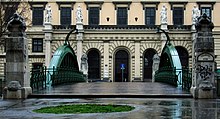Paul Wilhelm Eduard Sprenger

Paul Wilhelm Eduard Sprenger (born August 20, 1798 in Sagan , † October 29, 1854 in Vienna ) was an Austrian architect . He is considered one of the most important representatives of classicism in Austria .
life and work
After studying with Peter von Nobile , among others , he became a teacher at the Academy in Vienna in 1828 . From 1842 he was head of the court building office. In this role there was no getting around him for public construction contracts and he was consequently entrusted with all major construction contracts. Other architects, especially the younger generation, soon associated him with the hated bureaucratism of this office and called him the “ Metternich of architecture”. This system was changed in 1848 when tendering procedures were introduced.
He is known for the extreme practicality and economy of his buildings - which is probably why he was so popular at court. But it was an artistic principle with him. According to him, everything that the construction hides is “reprehensible” and unsatisfactory for “intellect and eye”. This was especially ridiculed by the generation of Ringstrasse architects as “civil servant architecture”, “bureaucratic style” and “symbol of the artistic impotence that had prevailed for so long”.
This assessment changed significantly in the 20th century, today Sprenger is considered to be an important forerunner of functionalist architecture, especially since he masterfully solved the relatively new building task of creating large official buildings. His use of different colored bricks as a decorative element can be found again in Theophil von Hansen and in his later buildings the window frames sometimes show historicizing elements.
His last notable work was the Altlerchenfeld parish church , although in the course of the revolution of 1848 a new tender was forced while construction was already in progress. It was completely rescheduled and is therefore also a kind of transitional work between classicism and historicism .
Sprenger died of cholera in 1854 .
In 1953, the Sprengersteig in Vienna- Ottakring (16th district) was named after him.
plant

- Main mint on Heumarkt , built 1835–1838
- Währinger water tower in Anton Baumann Park, built 1836–1841
- Regional Financial Directorate at Vorderen Zollamtsstrasse 3, built 1841–1847
- Main customs office , formerly Hintere Zollamtsstraße 4, built 1840–1844
- Lower Austrian Lieutenancy on Minoritenplatz, built 1846–1847
student
- Eduard van der Nüll (1812–1868)
literature
- Constantin von Wurzbach : Sprenger, Wilhelm Paul Eduard . In: Biographisches Lexikon des Kaiserthums Oesterreich . 36th part. Kaiserlich-Königliche Hof- und Staatsdruckerei, Vienna 1878, pp. 263–268 ( digitized version ).
- E. Schmalhofer: Sprenger Paul Eduard. In: Austrian Biographical Lexicon 1815–1950 (ÖBL). Volume 13, Verlag der Österreichischen Akademie der Wissenschaften, Vienna 2007–2010, ISBN 978-3-7001-6963-5 , p. 49 f. (Direct links on p. 49 , p. 50 ).
Web links
- Entry on Paul Wilhelm Eduard Sprenger in the Austria Forum (in the AEIOU Austria Lexicon )
Individual evidence
- ^ Hellmuth Andics: Gründerzeit. The black and yellow Vienna until 1867. Jugend & Volk, Munich 1981, p. 78
- ↑ The main customs office. District Museum Landstrasse, archived from the original on January 6, 2014 ; accessed on January 3, 2018 .
| personal data | |
|---|---|
| SURNAME | Sprenger, Paul Wilhelm Eduard |
| BRIEF DESCRIPTION | Austrian architect |
| DATE OF BIRTH | August 20, 1798 |
| PLACE OF BIRTH | Sagan , Poland |
| DATE OF DEATH | October 29, 1854 |
| Place of death | Vienna |
